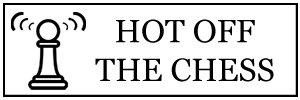
Round 2 of the Isle of Man International Chess Tournament 2018, picked up where round 1 had left off. There were no shocks among the big names, but they were not having it all their own way either.
Viswanathan Anand (2771), Sergey Karjakin (2760), Alexander Grischuk (2769) and Pavel Eljanov (2703), were among the round one winners that were held to draws. In Vishy Anand’s case, he had to fight extremely hard for all he got, too, as White against American Grandmaster, Robert Hess (2574).
Another former World Champion, who was up against it in this round, was Vladimir Kramnik (2779). He faced Alina Kashlinskaya (2447) as White. Vladimir had the better start, but a couple of loose moves allowed Alina to turn the tables on him.
In the diagram position, above, first, 21.Qc7(? Qxa7 was better) was strongly met by 21…g5. Textbook chess, here, from Kashlinskaya, countering on the opposite flank (or the centre) when being attacked on one flank. And this counter-attack is not without effect!
22.Nh3 was as horrid as it looks. The question was whether 22.Nd5 was any better and it seems that after 22…Nxd5 23.Bxd5 Bc8 24.Qxg7+ Kxg7 it is about equal. The thing is, though, White has no prospects any more.
Maybe Kramnik decided to maintain pieces, then, and I am certainly not going to argue with him. In saying that, it led to a worse position for him after 22…Bc8 23.Qxg7 Kxg7 24.a4 Neg4. A few moves later, he found himself completely shut in by his own pieces and totally, utterly, abysmally worse.
However, players like Vladimir Kramnik are rugged and resourceful and hard to beat and Alina Kashlinskaya was to find this out to the cost of half a point for her. After 67-moves, there was nothing to separate them and they shook hands to share the spoils. This was a very good performance from the Russian IM, though. A very hard fought game!
Elswehere, it was business as usual for top seeds, Levon Aronian (2780) and Maxime Vachier-Lagrave (2780). They won their games as Black, against Dennis Wagner (2572) and Puranik Abhimanyu (2547) respectively.
Another winner of the day (you might want to sit down) was the other top seed, Anish Giri (2780). He followed up on his draw of round 1 by going the whole hog and taking a full point in this one.
Mind you, he did play White against an opponent who was surrendering 600 rating points to him. No disrespect is intended at all to Glenn House (2180) but a Grandmaster of Anish’s standard should be able to do something in this game or hang his head in shame, especially as White.
I learned at club level, that if one is playing the Scheveningen Sicilian against a Dutchman, one should know what they are doing — not to mention how to pronounce it, but that’s another matter. I will just say that if you are thinking of saying ‘sher-ven-ingen’ … don’t.
Playing one’s openings against super-GMs is of very high value when it comes to highlighting weaknesses. Glenn will no doubt be somewhat disappointed that he didn’t offer up much resistance to Giri’s Keres Attack.
To be fair, though, it doesn’t seem like the Englishman did a huge amount wrong. Having said that, when playing those of Giri’s standard, one doesn’t have to make big errors in order to land in trouble. The diagram, below, shows the point that things started to slip, I believe.
Here, White is fractionally better but Black is not doing too badly. The point of this position is the b-file. The King’s are going to go to opposite wings and in that kind of situation, time is of the essence. Of course, at the moment, Black can’t castle anyway, due to White’s Bc5. So, time is doubly of the essence for House, here, because the last thing he wants is his King stuck in the centre.
His 15…Be6(?) was just too slow. It is a perfectly good developing move in itself, but it does not really do anything in this situation. Better options were …Be7, immediately challenging White’s Bc5 or …Rb8, wasting no time in firing along the b-file.
As it was, there came 16.f4 and here we see that Giri is not dallying at all in his targeting of the position of the Black King. The pawns advance, and if allowed to continue, will create chaos in the Black camp, opening up lines of access.
A further inaccuracy then came with House’s 16…Qb8(? …Rb8 was more accurate) Here, he treads on his own feet. And this becomes clear after 17.Kb1 Bf6 18.c4. This move would not be possible with a rook on b8 instead of the Queen, due to …Rxb2+. In that case, Giri would still be good after b2-b3, but the point is that Black must go the long way around now to make threats along the b-file, rather than making his opponent compromise. One can not afford this against top players.
And the problem when it came to activity, was finely illustrated by Black’s 18…Ra7, which said it all really. Chess really is amazing when it comes to just how quickly things can go from fine to …well, some other word beginning with ‘f’. Even though Anish did not accept the rook, he was still hugely better. Glenn’s position got steadily worse and he was resigning on move 25. He will not really be feeling that he acquitted himself well against one of the world’s top players I should think.
This score got Giri’s tournament underway, then, making him one of over thirty players on 1.5/2. Aronian and Vachier-Lagrave head a group of 19 players all on 2/2.

